

| Home | For sale | Site map | Contact information | Guest book | The Panzerschreck Lounge |
 The
improved Panzerschreck The
improved Panzerschreck  |
|---|
The Raketenpanzerbüchse 54/1 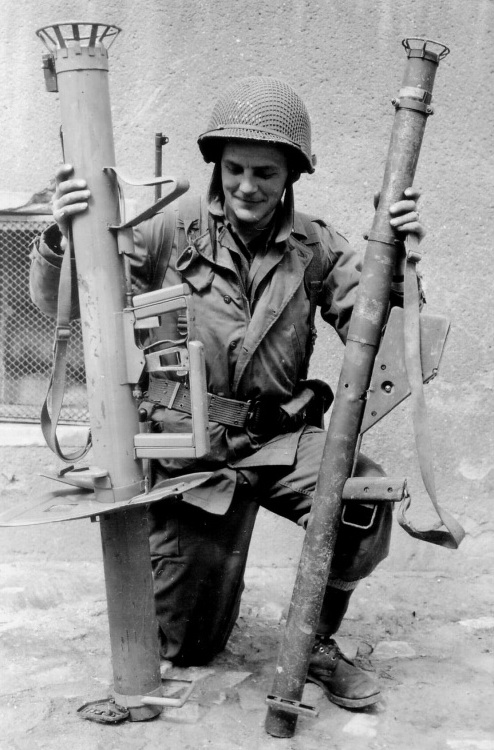 A very rare picture of the Raketenpanzerbüchse 54/1 that actually saw service. The The Panzerschreck
was a cumbersome
weapon to handle, both due to weight and length. Why the initial design
had that length of the tube is hard to say for sure. The rocket was
fin/drum stabilized once it left the tube and the actual length of the
launcher would not make much difference in regards to the accuracy. It
was most probably meant to help reduce the problems with the rocket
back-blast. The rocket motor continued to burn approximately 3,5 meters
(including the length of the tube) in it's trajectory. With the
introduction of the shield the issue with the rocket motor was
temporarily solved.
To remedy the problems with the long tube and extra weight and to implement the improvements already in use with the RPzB 54 an improved model was officially approved on 20 December 1944. The announcement was printed in the Heerestechnisches Verordnungsblatt issued on 15 January 1945.
The "new" weapon was in fact a Raketenpanzerbüchse 54 that had been shortened by 34 cm and due to the length reduction had lost 1,5 kg of it's weight. When the original document uses the term "verkürtze" (shortened) that was literally what it was. The RPzB54/1 was not a new made item, but in fact a RPzB 54 that had been shortened and modified. The process of rebuilding the RPzB 54 to the shorter RPzB 54/1 included the following steps:
The rear end of the
RPzB 54/1 (the crown) was totally rearranged. The
catch (Sperre) that prevented the rocket from falling
out of the rear after it had been inserted was redesigned and
repositioned. On the Raketenpanzerbüchse 54 it sat at the 12'o clock
position. On the Raketenpanzerbüchse 54/1 it was repositioned to the
2'o clock position. It also got a ramp to the rear that made it
possible to load the rocket without depressing the catch (See
the page
about the RPzB 54 tube).
The rear protection ring was also new and came in at least three different versions. The supporting struts were redesigned to aid in the loading of the rocket. This was done by bending them inwards so that the "step" was eliminated. One version lost the indented area and the number of supporting struts was increased from 6 to 7. The other version kept the indented area but the number of supporting struts was increased to 10. The third version had every second supporting strut bent while the rest was straight.  Given the relatively short time the RPzB 54/1 saw service the different designs are most certainly not a matter of product improvement, but more likely differences between the manufacturers. This makes it a really "oddball" weapon in terms of German Weapon manufacturing, as standardization always had been the goal. The three different versions also make it probable that there were at least three different companies rebuilding the RPzB 54. The
Steckerbuchse was at first located at the 10'o clock position. This
made it easy for the loader to plug in the contact from the rocket
motor. The drawback was that the loader had to be positioned on the
left side of the weapon in order to load it. On the RPzB54/1 the
Steckerbuchse was relocated to the 12'o clock position. The new outlet
socket was redesigned with a ring contact that did away with the need
for the separate wire and plug. The box had a movable switch marked
"St" for Steckerkontakt or "R" for Ringkontakt. In the "St" mode the
box would function like before, and a plug had to be inserted to feed
the current to the rocket motor to ignite it. This mode was used with
the old RPzB granate 4322. By depressing the plug outlet and sliding
the switch across to the "R" mode the plug would become a spring
activated contact pin. The tailfin of the new RPzB granate 4992 had a
separate contact ring so no wire was longer needed when it was
fired from the RPzB54/1. See the ammunition page for more details about
the improved rocket.
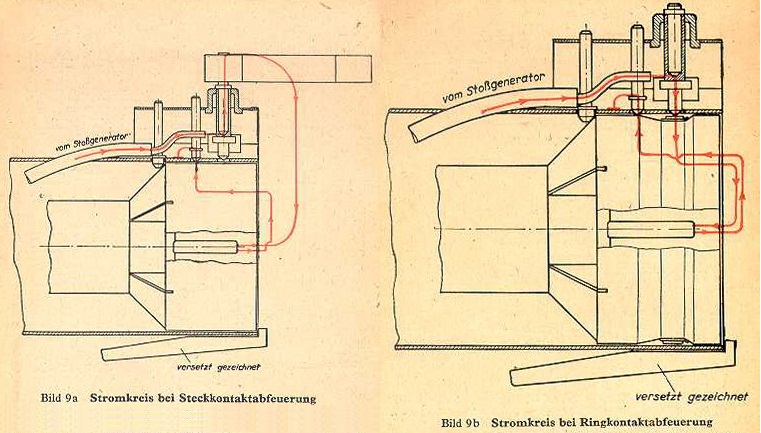 Two wiring diagrams from the D 1864/6 manual showing both methods of wiring used to ignite the rocket-engine The repositioning of
the
Steckerbuchse made it a little more awkward for the loader to plug in
the wire for the rocket motor as it now sat on top of the tube, but he
was able to position himself to either side of the weapon. With the
full introduction of the new rocket this wouldn't matter anyway, as
the Ringkontakt system did away with the need for the wire and plug
altogether.
Other changes to the overall design were that the shoulder block was totally omitted and the cable was moved to the right side of the tube to avoid it interfering with the firers shoulder. The rear mount for the sling was moved further to the front, but the front mount was left undisturbed. This would suggest that the weapon must have been "front-heavy" to carry with the sling over the shoulder. 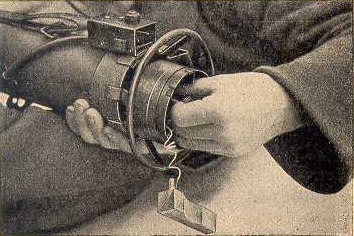 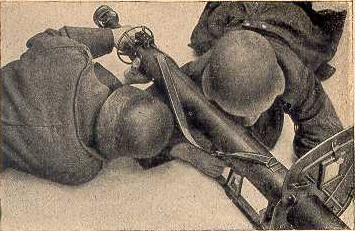 Two pictures from the D 1864/6 manual showing what I presume is a prototype weapon. The tube for the electric wire is on the wrong side of the launcher tube. Note also the Handschutz mounted on the shield The shield was kept unchanged, but incorporated the additional Handschutz, as discussed on the page about the shield. 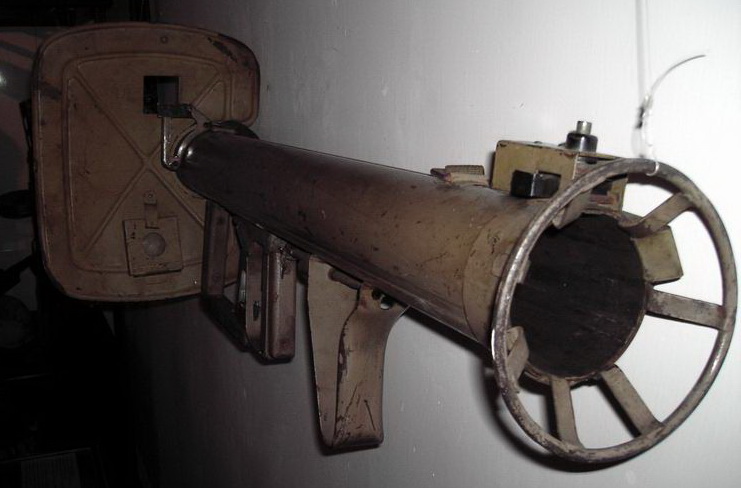 RPzB 54/1 with all the mentioned improvements and redesign visible except for the Handschutz, which appears to be missing The
main improvement for the system was the introduction of the new rocket,
the RPzB granate 4992, and the accompanying set of new sights.
The RPzB granate 4992 was cited as a "Kurzbrenner" (short-burner) in
German documents, but it is still unclear if they succeeded to perfect
it. A rocket motor that burned up entirely inside the tube would have
meant that the need for the shield no longer existed. The RPzB granate
4992 will be further discussed in the ammunition page.
I claim that the RPzB 54/1 was never manufactured. The 25.744 pieces that was delivered to the units by the end of March 1945 were all converted RPzB 54 that had been recalled from the Zeugämtern. A total number of 107.450 Panzerschrecks had been withdrawn, but only 25.744 was converted by the end of hostilities in Europe. Unfortunately, very few of the RPzB 54/1 survived. And pictures of them in use are even rarer, as the Kriegsberichters seems to have changed their cameras for guns at the end. By studying pictures of surviving examples it is easy enough to conclude that they originated from different periods of the production history. About 50% of the surviving examples of the RPzB 54/1 have the second model safety that had been introduced for the RPzB 54 by 10 October 1944. The remaining 50% of the RPzB 54/1 have the first model safety which would suggest manufacture prior to this date, which again strongly suggest that they started up as RPzB 54. Another tell-tale sign is the front sight. By June 1944 all Panzerschrecks being manufactured had the second model (thick) sight frame. Some of the RPzB 54/1 have the first model sight frame, and must have started their lives as a RPzB 54. 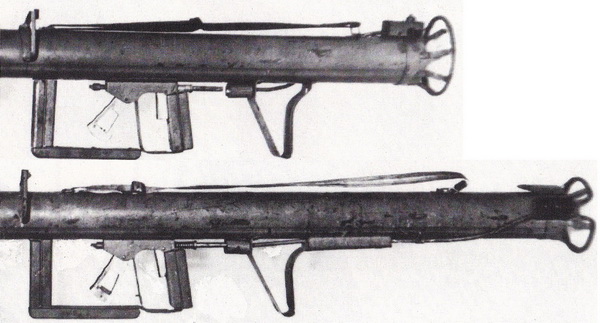 Both weapons shown for comparison. Apart from the sights they are identical all the way back to the shoulder rest. The differences between the models are easy to spot. |
| Home | For sale | Site map | Contact information | Guest book | The Panzerschreck Lounge |